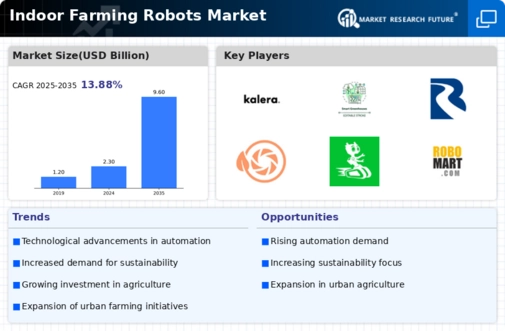Market Analysis
In-depth Analysis of Indoor Farming Robots Market Industry Landscape
The indoor farming robots market is influenced by several dynamic factors that shape its growth trajectory and competitiveness. One key driver of market dynamics is the increasing demand for sustainable agricultural solutions. With concerns about food security, climate change, and resource scarcity on the rise, there is a growing need for innovative farming technologies that can mitigate environmental impact and improve efficiency. Indoor farming robots offer a promising solution by enabling year-round cultivation in controlled environments, reducing water usage, and minimizing the reliance on chemical pesticides and fertilizers. As awareness of these benefits grows, so does the demand for indoor farming robots, driving market expansion.
Moreover, technological advancements play a significant role in shaping the market dynamics of indoor farming robots. Continuous innovation in robotics, automation, and sensor technologies enables manufacturers to develop more sophisticated and efficient solutions. These advancements result in robots that are capable of performing tasks with greater precision, monitoring plant health in real-time, and optimizing resource usage. As technology continues to evolve, indoor farming robots become more affordable, reliable, and accessible to a wider range of farmers and growers, fueling market growth and adoption.
Additionally, shifting consumer preferences and market trends contribute to the dynamic nature of the indoor farming robots market. Consumers are increasingly seeking locally sourced, organic produce that is free from pesticides and grown sustainably. Indoor farming robots enable farmers to meet these demands by producing high-quality crops closer to urban centers, reducing transportation costs and carbon emissions associated with traditional agriculture. As consumer awareness of the benefits of indoor farming grows, so does the market potential for indoor farming robots, driving further innovation and competition among industry players.
Furthermore, government policies and regulations play a crucial role in shaping the market dynamics of indoor farming robots. Many governments around the world are implementing initiatives to promote sustainable agriculture and support the adoption of innovative farming technologies. These initiatives may include grants, subsidies, or tax incentives for farmers investing in indoor farming robots, as well as regulations governing food safety standards and environmental sustainability. By creating a favorable regulatory environment and providing financial incentives, governments stimulate market growth and encourage industry players to develop solutions that meet regulatory requirements and market demands.
However, market dynamics in the indoor farming robots market are also influenced by various challenges and uncertainties. High initial investment costs, technological complexities, and scalability issues can hinder the widespread adoption of indoor farming robots, particularly among small-scale farmers and growers. Additionally, market fragmentation and lack of standardization pose challenges for both manufacturers and consumers, as the wide range of products and technologies available can make it difficult to compare and evaluate options effectively. Furthermore, concerns about data privacy and cybersecurity may also impact market dynamics, as farmers seek assurances that their sensitive data is protected from unauthorized access or misuse.
















Leave a Comment